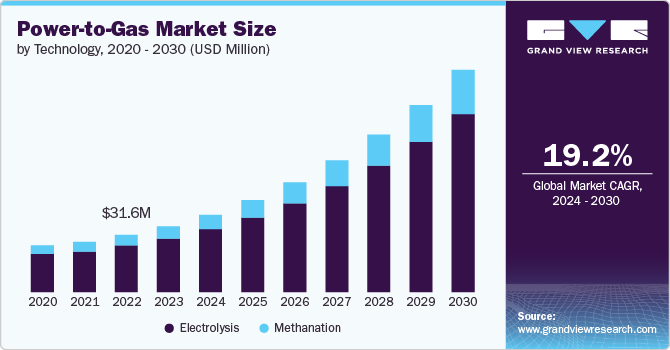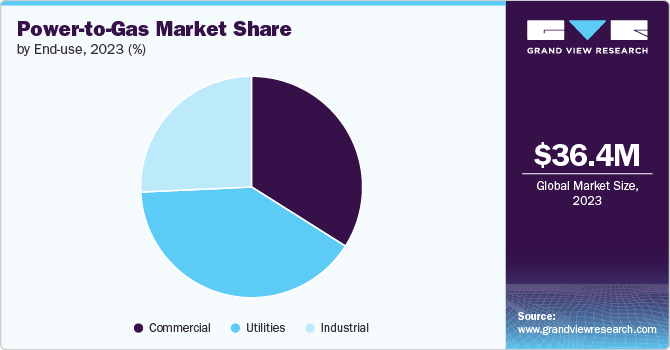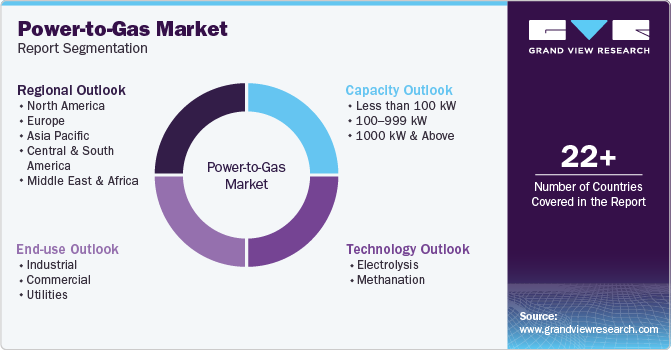- Home
- »
- Renewable Energy
- »
-
Power-to-Gas Market Size, Share & Trends Report, 2030GVR Report cover
![Power-to-Gas Market Size, Share & Trends Report]()
Power-to-Gas Market Size, Share & Trends Analysis Report By Technology (Electrolysis, Methanation), By Capacity (Less Than 100 kW, 100–999 kW, 1000 kW And Above), By End Use, By Region, And Segment Forecasts, 2024 - 2030
- Report ID: GVR-4-68040-457-7
- Number of Report Pages: 110
- Format: PDF, Horizon Databook
- Historical Range: 2018 - 2022
- Forecast Period: 2024 - 2030
- Industry: Energy & Power
Power-to-Gas Market Size & Trends
The global power-to-gas market size was valued at USD 36.35 million in 2023 and is expected to grow at a CAGR of 19.2% from 2024 to 2030. The market is driven by several key factors, including the increasing utilization of renewable energy resources for power generation and the integrated management of power-to-gas technology. The growing demand for green hydrogen across various industries, particularly in Europe and Asia-Pacific, is a major driver as nations aim to reduce carbon emissions and enhance energy security.

Additionally, the potential use of hydrogen in mobility solutions and as a substitute for natural gas presents attractive opportunities for market growth. The need for effective energy storage solutions to address the intermittency of renewable energy sources is also a significant driver for the power-to-gas industry.
Drivers, Opportunities & Restraints
Global efforts to reduce greenhouse gas emissions are propelling demand for power-to-gas technologies. Governments are implementing regulations and incentives to promote cleaner energy solutions, particularly in the transportation and industrial sectors. Advances in electrolysis technology and decreasing capital costs are making power-to-gas solutions more economically viable, further stimulating market growth.
The power-to-gas market faces several restraints that could hinder its growth. A primary challenge is the high capital cost associated with establishing power-to-gas systems, which can deter adoption, especially in middle- and low-income countries. Additionally, the low efficiency of these systems results in significant energy losses during the conversion processes, with estimates of 20-30% loss during electrolysis and 40-50% during methanation.
The power-to-gas market presents numerous opportunities for growth, particularly driven by the increasing demand for renewable hydrogen across various sectors, including transportation, chemicals, and energy. As governments worldwide implement policies to promote clean energy and reduce carbon emissions, investments in power-to-gas technologies are expected to rise.
Technology Insights & Trends
Based on technology, electrolysis held the largest revenue share of 81.19% in 2023. The market, particularly through electrolysis, is poised for significant growth, driven by the increasing demand for green hydrogen and the integration of renewable energy sources. Electrolysis technology is anticipated to dominate the market due to its efficiency in converting excess renewable energy into hydrogen, facilitating energy storage, and grid balancing.
Methanation technology, which converts hydrogen and carbon dioxide into methane, is anticipated to witness strong growth in the coming years due to its ability to directly replace natural gas without requiring additional infrastructure development. The utilities and industrial sectors are projected to be the fastest-growing end-user segments, reflecting the growing adoption of power-to-gas technologies for grid balancing and sustainable energy production. Europe is expected to lead the market, driven by the region's focus on reducing greenhouse gas emissions and promoting the use of renewable gases.
Capacity Insights & Trends
Based on capacity, the less than 100 kW segment held the largest revenue share of 43.89% in 2023. The drivers for the less than 100 kW power-to-gas market through methanation include the increasing focus on decentralized energy solutions and the integration of renewable energy sources. Small-scale methanation systems allow for efficient conversion of renewable hydrogen and carbon dioxide into synthetic methane, making them attractive for local energy applications.
The growing emphasis on reducing carbon emissions and enhancing energy security further supports the adoption of these technologies. Additionally, pilot projects and demonstrations are fostering innovation and showcasing the viability of smaller methanation units, encouraging investment and interest from commercial and industrial sectors seeking sustainable energy alternatives.
End Use Insights & Trends
Based on end use, the utility segment held the largest revenue share of 40.19% in 2023. The sector is driven by the increasing need for decarbonization and the effective integration of renewable energy sources. Utilities are focusing on producing hydrogen through power-to-gas technologies to enhance energy storage and grid stability, addressing the challenges posed by intermittent renewable generation. The growing emphasis on reducing greenhouse gas emissions is prompting utilities to adopt cleaner energy solutions, further accelerating market growth.

The market in the commercial sector is driven by several key factors, including the increasing focus on sustainability and the need for energy resilience. Businesses are adopting power-to-gas technologies to convert surplus renewable energy into hydrogen or methane, enabling them to reduce carbon emissions and meet regulatory requirements. The demand for localized energy storage solutions is also rising, as companies seek to enhance their energy independence and mitigate the risks associated with energy price volatility. Furthermore, advancements in technology are improving the efficiency and cost-effectiveness of power-to-gas systems, making them more attractive for commercial applications.
Regional Insights & Trends
North America power-to-gas market is characterized by a growing emphasis on renewable energy integration and the development of sustainable energy solutions. Increasing investments in green hydrogen production and the utilization of power-to-gas technologies are driven by regulatory support aimed at reducing carbon emissions. The market is also marked by advancements in electrolysis and methanation technologies, enhancing the efficiency of converting surplus renewable energy into hydrogen and methane.
U.S. Power-to-Gas Market Trends
The power-to-gas market in the U.S. is growing as the country is witnessing an increasing focus on green hydrogen production and the utilization of power-to-gas technologies, driven by regulatory support aimed at reducing carbon emissions and promoting clean energy initiatives. The market is marked by advancements in electrolysis and methanation technologies, enhancing the efficiency of converting surplus renewable electricity into hydrogen and methane.
Europe Power-to-Gas Market Trends
The power-to-gas market in Europe dominated the global industry and accounted for the largest revenue share of over 44.46% in 2023. The drivers of the European market include the urgent need for decarbonization and the effective integration of renewable energy sources into the energy system. Rising concerns over carbon emissions are prompting European nations to adopt power-to-gas technologies, which convert excess renewable energy into hydrogen and methane, facilitating energy storage and enhancing grid stability.
Additionally, supportive government policies and ambitious climate targets are fostering investments in this sector. The growing demand for green hydrogen across various industries, along with advancements in electrolysis and methanation technologies, further propels the market, positioning Europe as a leader in sustainable energy solutions.
Germany power-to-gas market is at the forefront of the European region, driven by ambitious renewable energy targets and supportive government policies. As of 2020, the country was home to around 40 small power-to-gas pilot projects that utilize surplus green power from wind and solar to produce zero-carbon hydrogen through electrolysis.
The power-to-gas market in France is growing with a focus on renewable hydrogen production and integration into the energy system. As of 2020, France had around 10 power-to-gas pilot projects, primarily utilizing surplus renewable electricity from wind and solar to produce hydrogen through electrolysis. The country aims to build a power-to-gas capacity of 6.5 GW by 2030, driven by supportive government policies and funding.
Asia Pacific Power-to-Gas Market Trends
The power-to-gas market in Asia Pacific is growing as the region has seen a significant rise in the adoption of renewable energy sources, particularly solar and wind power, which has led to the need for effective energy storage solutions. Power-to-gas technologies can help convert excess renewable electricity into hydrogen or methane, enabling better integration of these intermittent sources into the grid.
China power-to-gas market is driven by several key factors. The country is increasingly prioritizing renewable energy integration to combat air pollution and reduce greenhouse gas emissions, leading to a significant investment in power-to-gas technologies. Government policies and regulations promoting hydrogen production and sustainable energy solutions are further enhancing market growth.
The power-to-gas market in Japan is fueled by several key factors. The country is heavily investing in renewable energy integration, particularly after the Fukushima disaster, which has heightened the focus on energy security and sustainability. Government initiatives aimed at reducing greenhouse gas emissions and promoting hydrogen as a clean energy source are pivotal in driving market expansion. Japan's commitment to developing a hydrogen economy is reflected in its policies supporting power-to-gas technologies, which convert excess renewable energy into hydrogen and synthetic methane.
Central & South America Power-to-Gas Market Trends
The power-to-gas market in Central and South America is driven by increasing investments in renewable energy and the need for sustainable solutions to address energy security. Governments are implementing policies to promote clean energy technologies, enhancing the viability of power-to-gas systems.
Middle East & Africa Power-to-Gas Market Trends
The power-to-gas market in the Middle East and Africa is driven by the region's abundant renewable energy resources, particularly solar power, and the growing demand for clean energy solutions. Supportive government policies and regulations aimed at reducing carbon emissions are further propelling market growth. Additionally, the need for energy storage and grid stability is driving investments in power-to-gas technologies in the region.
Key Power-to-Gas Company Insights
The market is highly competitive, with several key players operating globally. Key players in this market are focusing on technologies such as electrolysis and methanation to convert excess renewable energy into hydrogen and synthetic fuels. The market is driven by increasing demand for green hydrogen across various industries and the need for effective energy storage solutions, particularly in Europe and Asia-Pacific, as nations aim to reduce carbon emissions and enhance energy security.
Key Power-to-Gas Companies:
The following are the leading companies in the power-to-gas market. These companies collectively hold the largest market share and dictate industry trends.
- Hydrogenics
- ITM Power
- McPhy Energy
- Fuelcell Energy
- Nel Hydrogen
- ThyssenKrupp
- Electrochaea
- Carbotech
- Aquahydrex
- Ineratec
Recent Developments
-
In November 2023, Nature Energy and Andel inaugurated a new power-to-gas facility in Denmark, following a partnership established in autumn 2022. The two companies have invested in a biological Power-to-X plant located in Glansager on Als, which is now ready for production. Once fully operational, the plant will produce hydrogen that will enhance Nature Energy's green gas output by 12,000 m³ per day.
Power-to-Gas Market Report Scope
Report Attribute
Details
Market size value in 2024
USD 42.73 million
Revenue forecast in 2030
USD 122.56 million
Growth rate
CAGR of 19.2% from 2024 to 2030
Historical data
2018 - 2022
Base Year
2023
Forecast period
2024 - 2030
Quantitative units
Revenue in USD million/billion and CAGR from 2024 to 2030
Report coverage
Revenue forecast, competitive landscape, growth factors and trends
Segments covered
Capacity, technology, end use, region
Regional scope
North America; Europe; Asia Pacific; Central & South America; Middle East & Africa
U.S.; Canada; Mexico; Germany; France; UK; Italy; Spain; Russia; China; India; Japan; Australia; Brazil; Argentina; Saudi Arabia; South Africa; UAE
Key companies profiled
Hydrogenics, ITM Power, McPhy Energy, Fuelcell Energy, Nel Hydrogen, ThyssenKrupp, Electrochaea, Carbotech, Aquahydrex, Ineratec
Customization scope
Free report customization (equivalent up to 8 analyst’s working days) with purchase. Addition or alteration to country, regional & segment scope
Pricing and purchase options
Avail customized purchase options to meet your exact research needs. Explore purchase options
Global Power-to-Gas Market Report Segmentation
This report forecasts revenue growth at global, regional, and country levels and provides an analysis of the latest industry trends in each of the sub-segments from 2018 to 2030. For this study, Grand View Research has segmented the global power-to-gas market report on the basis of technology, capacity, end-use and region:

-
Technology Outlook (Revenue, USD Million, 2018 - 2030)
-
Electrolysis
-
Methanation
-
-
Capacity Outlook (Revenue, USD Million, 2018 - 2030)
-
Less than 100 kW
-
100-999 kW
-
1000 kW and Above
-
-
End Use Outlook (Revenue, USD Million, 2018 - 2030)
-
Industrial
-
Commercial
-
Utilities
-
-
Regional Outlook (Revenue, USD Million, 2018 - 2030)
-
North America
-
U.S.
-
Canada
-
Mexico
-
-
Europe
-
Germany
-
UK
-
Italy
-
Spain
-
France
-
Russia
-
-
Asia Pacific
-
China
-
India
-
Japan
-
Australia
-
-
Central & South America
-
Brazil
-
Argentina
-
-
Middle East & Africa
-
Saudi Arabia
-
South Africa
-
UAE
-
-
Frequently Asked Questions About This Report
b. The global power-to-gas market size was estimated at USD 36.35 million in 2023 and is expected to reach USD 42.73 million in 2024.
b. The global power-to-gas market is expected to witness a compound annual growth rate of 19.2% from 2024 to 2030 to reach USD 122.56 million by 2030.
b. The Electrolysis segment occupied the largest power-to-gas market share of about 81.19% in 2023. The power-to-gas market, particularly through electrolysis, is poised for significant growth, driven by the increasing demand for green hydrogen and the integration of renewable energy sources.
b. Some key players operating in the power-to-gas market include Hydrogenics, ITM Power, McPhy Energy, Fuelcell Energy, Nel Hydrogen, among others.
b. The global power-to-gas market is driven by several key factors, including the increasing utilization of renewable energy resources for power generation and the integrated management of power-to-gas technology.
Share this report with your colleague or friend.
![gvr icn]()
NEED A CUSTOM REPORT?
We can customize every report - free of charge - including purchasing stand-alone sections or country-level reports, as well as offer affordable discounts for start-ups & universities. Contact us now
![Certified Icon]()
We are GDPR and CCPA compliant! Your transaction & personal information is safe and secure. For more details, please read our privacy policy.
We are committed towards customer satisfaction, and quality service.
"The quality of research they have done for us has been excellent."





